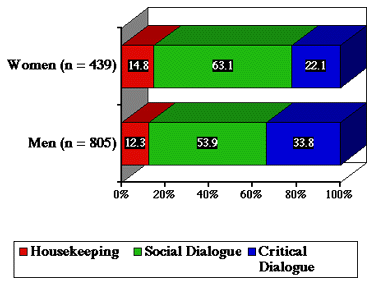Next || Previous ||
"WIRED FROSH" Contents
09a: Perceived Usefulness of E-mail List
vs. Other Media by Social Purpose (By Gender)
Discussion
|
Social
Purpose
|
OTHER
MEDIA
|
E-MAIL
LIST
|
|
(scale = 0-3)
|
Women
|
Men
|
Women
|
Men
|
|
HOUSEKEEPING
|
1.66
|
1.72
|
2.49
|
2.39
|
|
SOCIAL
DIALOGUE
|
1.74
|
1.70
|
2.30
|
2.04
|
|
CRITICAL
DIALOGUE
|
1.57
|
1.67
|
1.75
|
2.30
|
09b: Actual Use of E-mail List by Women
and Men According to Social Purpose
Discussion

DISCUSSION
Looking in more detail (than 08) at participation
by gender, and looking at the actual participation in the context of men's and
women's perceptions about the e-mail list, we can conclude the following:
- (09a) Women found the e-mail list more
useful than men did for social dialogue (2.30 vs. 2.04), while men
found the e-mail list significantly more useful than women did for
critical dialogue (2.30 vs. 1.75). Women and men found the list
about equally useful for housekeeping purposes (2.49, 2.39).
- (09b) Perhaps not surprisingly, these
perceptions were mirrored in actual use of the e-mail list. Over
63% of women's messages were categorized as social dialogue and
about 22% as critical dialogue, while 54% of men's messages were
social dialogue and nearly 34% critical dialogue; about the same
proportions (14.8% and 12.3%) of women's and men's messages were
categorized as housekeeping.
These results somewhat corroborate studies claiming that women and men tend
to use computer-mediated communication (CMC) and other communication for different
purposes (such as studies cited by Herring 1996b),
and also studies suggesting that women prefer a collaborative, supportive conversational
style to the more competitive and combative "debate" style that often characterizes
"critical dialogue" in academia and as I've defined it for this study.
Next || Previous ||
"WIRED FROSH" Contents
© Copyright 1997 by Richard
Holeton and Stanford University

